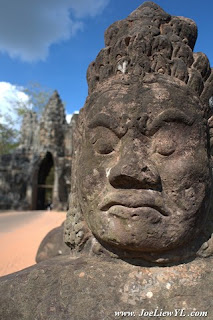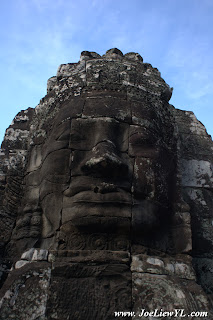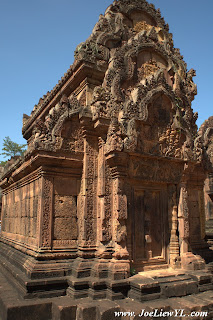Event: Angkor Wat International Half Marathon 2011
Date: 4th December 2011
Time: 0630am
Venue: Angkor Wat (Siem Reap, Cambodia)
Distance: 21km
Angkor Wat International Half Marathon 2011
A Charity Run organized by the National Olympic Committee of Cambodia and the Khmer Amateur Athletics Federation, specially cooperated by NPO/NGO Hearts of Gold & The Japan Medical Joggers Association to bring Artificial Limbs for Cambodia's land mines survivors and save the youth of cambodia from HIV/AIDS.
We Ran The Path of Ancient Angkor Wat
With the Angkor Wat International Half Marathon 2011 that is held on 4th-Dec-2011 (Sunday), my fellow running buddies and I planned for a Marathon (cum exploration) trip of a 5days-&-4nights retreat into the Ancient Angkor Wat and its heritage in Siem Reap, Cambodia.
Departing for Siem Reap from Kuala Lumpur on 01st-Dec-2011 and returning to KL on 05th-Dec-2011 by AirAsia; our group of runners consisted of Lillian Lee, John Chuah & family (4pax) and me on the same flight, while Joannita & Noor Othman will be arriving on the very next day. This trip with its Primary Objective of Marathon Running were soon replaced by our secondary objective which was CARBO-LOADING with AMOK (Seriously not my favourite), CHEAP Beers (USD$0.50 - 0.75 for Angkor Beer) and huge COCONUTS (USD$0.75)
With Carbo-Loading being set as our Primary Objective, Sight-Seeing was then set as our Secondary Objective; with all the 2 objectives completed, we focus on our final objective that was the "Angkor Wat International Half Marathon 2011" with excitement & enthusiasm to run along the Angkor Wat Heritage path.
Picture speaks louder than words, so lets go into visual colors.
Flag of the "Kingdom Of Cambodia"
Welcome to Siem Reap!
Onboard AK1480 bound for Siem Reap, Cambodia.
Uncle John Chuah was curious and excited to conquer
Angkor Wat with his "Super-Star Legs"
Siem Reap International Airport Terminal Building
A Khmer statue right before the
Cambodian Immigration counter
to welcome visitors
Another Khmer statue right after immigration clearance
John Chuah & Family
The family came along for a vacation and supports
for his 21km marathon
Trafff'ians
(Lillian Lee & John Chuah)
Our Tuk-Tuk ride from the airport to our hotel
(John Chuah & Family)
My Tuk-Tuk driver
(My ride with John Chuah)
Hotel Golden Temple Villa
Main Entrance of
Hotel Golden Temple Villa
The streets of Siem Reap
Most of the buildings in Siem Reap
is shorter than a coconut tree
Show-Time Cinema
Lunch at "The Red Piano".
"Joe To Go" Any taker?
CHEAP beers...2 quarters
Rich in Protein, But not my kind of diet.
Angkor Beer 3 quarters (USD$ 0.75)
Hotel rates, some are price at 2quarters on the streets.
Amok! Beef, Chicken, Fish & perhaps Pork as well (upon request)
Of course I am here for AWIHM run,
needs to collect running bib
No. 1076 (Liew Yaw Loong)
M-1077
Our supposedly tour guide
(Voted by lonely planet as the Golden Tour guide around Angkor Wat)
But she was down with flu & cold, so she send in her Golden Assistant
Thanx to John Chuah for AW arrangement
3 days pass to tour around the Angkor Heritage
Sunset at Phnom Bakheng
(John Chuah)
Angkor Wat
(John Chuah & Wife)
Me in Angkor Wat
Trafff'ians with Angkor Wat & its shadow.
2nd level inside Angkor Wat,
The Hieroglyphics Walk-Way.
(* Courtesy of Lillian Lee)
Mysterious Bayon
Ta Phrom
Trunk Raiders
I'm just following the pictures on the wall
Boat ride to TonLe Sap Floating village
(John Chuah)
42km Runners
We Ran Angkor Wat for Fun, Food & Friendship
(From Left: Noor, Joannita, KK Yum & Me)
A fine drink to clear KK's throat after
much sharing of his Marathon Path.
BeetRoot & HorseRadish Cheese Burger
Post Run meal
Run Day (4th-Dec-2011 / Sunday)
Our group of Trafff'ians got up at 05:30am to gear-up in our compression preparing for battle...Haha! Preparing for the Run Fun of Angkor Wat International Half Marathon 2011.
Left our Hotel at 06:00am in our earlier reserved van, with John Chua, Lillian Lee, Joannita, Noor and me. Pretty much excited with the hooha fun & route, but most of all the nice cooling weather that will soon chill our muscles as we enroute onto the Half Marathon route.
Here are some pictures took moments before the run starts, along the running routes and the after run photo session.
* Courtesy from Joannita
* Courtesy from Joannita
* Courtesy from Joannita
* Courtesy from Joannita
* Courtesy from Joannita
Joannita
We run for the same cause!
Photo with Noor
My Run in Angkor Wat International Half-Marathon 2011
My Running Bib
21km Result: 1:50:41
I was speaking to Joannita back in Angkor Wat and she read a quote to me
"If you want to win something, run 100 meters;
If you want to experience something, run a marathon" - Emil Zatopek
Khmer Heritage in Siem Reap, Cambodia
Angkor Wat
Angkor Wat is a temple complex at Angkor, Cambodia, built for the King Suryavarman II in the early 12th century as his state temple and capital city. As the best-preserved temple at the site, it is the only one to have remained a significant religiuos centre since its foundation - first Hindu, dedicated to the god Vishnu, then Buddhist. It is the world's largest religious building.
The temple is at the top of the high classical style of Khmer Architecture. It has become a symbol of Cambodia, appearing on its national flag and it is the country's prime / major attraction for tourism. Angkor Wat combines two basic plans of Khmer temple architectures: the temple mountain and the later galleried temple, based on early South Indian Hindu Architecture, with key features such as the Jagati.
It is designed to represent Mount Meru, home of the Devas in Hindu Mythology: within a moat and an outer wall 3.6km (2.2mi) long are three rectangular galleries, each raised above the next. At the centre of the temple stands a quincunx of towers, unlike most Angkorian temples; Angkor Wat is oriented to the west, scholars are divided as to the significance of this. The temple is admired for the grandeur and harmony of the architecture, its extensive bas-reliefs, and for the numerous devatas (guardian spirits) adoring its walls.
* Write-Ups are sourced from wikipedia, for more details kindly click the link below.
Naga: The SEVEN Headed Serpant
Bullet holes left during the modern warfare
Ancient Khmer Hierogliphics pictures sculpted along
this walk-way
Bayon
Bayon is a well-known and richly decorated Khmer temple at Angkor in Cambodia. Built in the late 12th century or early 13th century as the official state temple of the Mahayana Buddhist King Jayavarman VII, the Bayon stands at the centre of Jayavarman's capital, Angkor Thom. Following Jayavarman's death, it was modified and augmented by later Hindu and Theravada Buddhist kings in accordance with their own religiuos preferences.
The Bayon's most distinctive feature is the multitude of serene and massive stone faces on the many towers which jut-out from the upper terrace and cluster around its central peak. The temple is known also for two impressive sets of bas-reliefs, which present an unusual combination of mythological, historical and mundane scenes. The current main conservatory body, the Japanese Government team for the Safeguarding of Angkor (the JSA) has described the temple as "the most striking expression of the baroque style" of Khmer Architecture, as contrasted with the classical style of Angkor Wat.
* Write-Ups are sourced from wikipedia, for more details kindly click the link below.
Ta Prohm
Ta Prohm is the modern name of a temple at Angkor, Siem Reap Province, Cambodia. Built in the Bayon style largely in the late 12th and early 13th centuries and originally called Rajavihara. Located approximately 1 kilometer east of Angkor Thom and on the southern edge of the East Baray. It was founded by the Khmer King Jayavarman VII as a Mahayana Buddhist monastery and university.
Unlike most Angkorian temples, Ta Prohm has been left in much the same condition in which it was found; the photogenic and atmospheric combination of trees growing out of the ruins and the jungle surroundings have made it one of Angkor's most popular temples with visitors.
* Write-Ups are sourced from wikipedia, for more details kindly click the link below.
Door Passage within Ta Phrom Complex
Hieroglyphics
Restoration-In-Progress for the Heritage
Banteay Srei
Banteay Srei or Banteay Srey is a 10th century Cambodian temple dedicated to the Hindu god Shiva. Located in the area of Angkor in Cambodia. It lies near the hill of Phnom Dei, 25km (16mi) north-east of the main group of temples that once belonged to the medieval capitals of Yasodharapura and Angkor Thom.
Banteay Srei is built largely of red sandstone, a medium that lends itself to the elaborate decorative wall carvings whic are still observable today. The buildings themselves are miniature in scale, unusually so when measured by the standards of Angkorian construction. These factors have made the temple extremely popular with tourists, and have led to its bring widely praised as a "Precious Gem", or the "Jewel of Khmer Art".
* Write-Ups are sourced from wikipedia, for more details kindly click the link below.http://en.wikipedia.org/wiki/Banteay_Srei
Phnom Bakhen Hill Temple (SunSet View)
Phnom Bakhen at Angkor, Cambodia, is a Hindu temple in the form of a temple mountain. Dedicated to Shiva, it was built at the end of the 9th century, during the reign of King Yasovarman (889-910). Located atop a hill, it is nowadays a popular tourist spot for sunset views of the much bigger temple Angkor Wat, which lies amid the jungle about 1.5km to the southeast. The large number of visitors makes Phnom Bakheng one of the most threatened monuments of Angkor.
Constructed more than two centuries before Angkor Wat, Phnom Bakheng was in its day the principal temple of the Angkor region, historians believe. It was the architectural centerpiece of a new capital, Yasodharapura, the Yasovarman built when he moved the court from the capital Hariharalaya in the Roluos area located to the southeast.
http://en.wikipedia.org/wiki/Phnom_Bakheng
Tonlé Sap Lake - Floating Village
The Tonlé Sap is a combined lake and river system in Cambodia that is also the largest body of water in SOuth East Asia. The Tonlé Sap remains relatively small for most of the year, measuring about a meter in depth and covering around 2,700 square kilometers.
However, the river that connects to the lake starts to swell during the monsoon season as water that flows from the Mekong river reverses, helping to expand the Tonlé Sap up to 16,000 square kilometers with a depth up to 9 metres deep.
Surrounding fields become flooded with the floodplains acting as the core breeding f=ground for the Tonlé Sap's plentiful supply of fish.
The seasonal flow from lake and river are responsible for creating more that 75% of Cambodia's fresh water fish catch and are estimated to directly support more than 3 million people.
http://tonlesap.net/
Along the road to TonLe Sap Lake Floating Village
* Write-up are sourced from various web-sites, for more details kindly click on the link provided.
* Pictures posted in the Heritage columns are sequenced based upon my path as I go through the heritage.











































































































































































































































































































